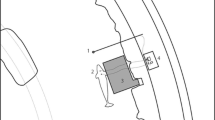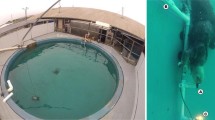Summary
-
1.
The auditory capacities in the stone perch (Acerina cernua) and the pike perch (Lucioperca sandra) were determined by electric shock training.
-
2.
The upper frequency limit was at 500 cps and 60 dB (0 dB = 1 μbar) inAcerina, with strong individual variations (Figs. 6 and 7, Table 1), and at 800 cps and 60 dB inLucioperca (Figs. 9 and 11, Table 2). The highest sensitivity was at 100 cps inAcerina and below 200 cps inLucioperca. Frequencies below 50 cps were not tested.
-
3.
The optimum shock level was determined to be 10 volts a. c. The essential number of tests to reach the criterion varied according to shock intensity (Acerina, Fig. 3).
-
4.
Stone perches learned more rapidly when trained at 100 cps (88.6 tests) than at 200 cps (126 tests) with the electric stimulus level invaried.
-
5.
Spontaneous reactions to sound were observed with all the pike perches and approximately half of the stone perches tested.
-
6.
The optimum auditory perception range ofLucioperca coincided well with the main frequency range of sounds produced by this species, as described byProtasov (1965; Figs. 9, 11 and 13).
Zusammenfassung
-
1.
Vermittels elektrischer Strafdressur wurde das Hörvermögen von Kaulbarsch (Acerina cernua) und Zander (Lucioperca sandra) untersucht.
-
2.
Die obere Hörgrenze liegt, mit starken individuellen Unterschieden, beim Kaulbarsch mit 60 dB (0 dB = 1 μbar) bei 500 Hz (Abb. 6 und 7, Tabelle 1). Für den Zander wurde sie mit 60 dB zu 800 Hz bestimmt (Abb. 9 und 11, Tabelle 2). Das Perzeptionsoptimum liegt beim Kaulbarsch um 100 Hz und für den Zander unterhalb von 200 Hz. Töne unter 50 Hz wurden nicht geprüft.
-
3.
Als optimaler Strafreiz erwiesen sich elektrische Wechselstromschläge von 10 Volt. Bei geringerer oder höherer Strafe war eine größere Anzahl von Versuchen bis zum Erreichen des Kriteriums erforderlich (Kaulbarsch, Abb. 3).
-
4.
Bei 100 Hz trainierte Kaulbarsche lernten durchschnittlich schneller (88,6 Versuche) als solche, die bei gleicher Strafreizhöhe mit 200 Hz trainiert wurden (126 Versuche).
-
5.
Spontane Reaktionen auf Töne traten bei allen untersuchten Zandern und bei ca. der Hälfte der Kaulbarsche auf.
-
6.
Das Schallperzeptionsoptimum des Zanders stimmt gut mit dem vonProtasov (1965) angegebenen Hauptfrequenzbereich der von dieser Art produzierten Laute überein (Abb. 9, 11 und 13).
Similar content being viewed by others
Literatur
Behrend,E., andM. E. Bitterman: Avoidance conditioning in the goldfish: exploratory studies of the CS-US interval. Amer. J. Psychol.75, 18–34 (1962).
Bekesy,G. v.: A new audiometer. Acta oto-laryng. (Stockh.)35, 411–422 (1947).
Bergeijk,W. A. van: Directional and nondirectional hearing in fish. In:W. N. Tavolga (ed.), Marine Bio-acoustics, p. 281–299. Oxford-London-New York-Paris: Pergamon Press 1964.
Cohen,M. J., andH. E. Winn: Electrophysiological observations on hearing and sound production in the fish,Porichthys notatus. J. exp. Zool.165, 355–369 (1967).
Cornsweet,T. N.: The staircase-method in psychophysics. Amer. J. Psychol.75, 485–491 (1962).
Diesselhorst,G.: Hörversuche an Fischen ohne Weberschen Apparat. Z. vergl. Physiol.25, 748–783 (1938).
Dijkgraaf,S.: Sound reception in the dogfish. Nature (Lond.)197, 93–94 (1963).
Dixon,W. J., andA. M. Mood: A method for obtaining and analyzing sensitivity data. J. Amer. Statistic. Ass.43, 109–126 (1948).
Enger,P. S.: Acoustic threshold in goldfish and its relation to the sound source distance. Comp. Biochem. Physiol.18, 859–868 (1966).
—: Hearing in herring. Comp. Biochem. Physiol.22, 527–538 (1967).
—, andR. Andersen: An electrophysiological field study of hearing in fish. Comp. Biochem. Physiol.22, 517–525 (1967).
Freytag,G.: Zur Frage der Meßgenauigkeit bei hydrobioakustischen Untersuchungen in Aquarien und Flachwassergebieten. Helgol. wiss. Meeresunters.15, 47–63 (1967).
Friedrich, T.: Investigations to determine some properties of sound propagation in a dry dock with the intention to carry out experiments on the reaction of fish in the dock to various sounds, in particular noise from trawls and trawlers in the sea. The working group for development of Pelagic One-Boat Trawl, Arbeitsutvalget for utvikling av pelagisk enbatstral, Bergen, Norwegen, Oppdrag Nr. 620213 (1964).
Frisch,K. v.: Über den Gehörsinn der Fische. Biol. Rev.11, 210–246 (1936).
Grözinger,B.: Elektro-physiologische Untersuchungen an der Hörbahn der Schleie (Tinca tinca [L.]). Z. vergl. Physiol.57, 44–76 (1967).
Harris,G. G., andW. A. van Bergeijk: Evidence that the lateral line organ responds to near-field displacements of sound sources in water. J. acoust. Soc. Amer.34, 1831–1841 (1962).
Horner,J. L.,N. Longo, andM. E. Bitterman: A shuttle box for fish and a control circuit of general applicability. Amer. J. Psychol.74, 114–120 (1961).
Kleerekoper,H., andP. A. Roggenkamp: An experimental study on the effect of the swimbladder on hearing inAmiurus nebulosus n. (Leseur). Canad. J. Zool.37, 1–8 (1959).
Mohr,H.: Aquarienversuche zur Ermittlung des Hörbereiches beim Kabeljau (Gadus callarias L.). I. Spontane Reaktionen auf Töne. Protokolle zur Fischereit.9, 382–392 (1965).
—: Dressurversuche über die Wahrnehmung von Lotschall beim Kabeljau. Protokolle zur Fischereit,10, 130–142 (1966).
Protasov,V. R.: Bioakustik der Fische. [Russ.]. 207 S. Moskau: Verlag der Wissenschaften 1965.
Schneider,H.: Die Bedeutung der Atemhöhle der Labyrinthfische für ihr Hörvermögen. Z. vergl. Physiol.29, 172–194 (1942).
Schwartzkopff,J.: Vergleichende Physiologie des Gehörs. Fortschr. Zool.12, 206–264 (1960).
—: Vergleichende Physiologie des Gehörs und der Lautäußerungen. Fortschr. Zool.15, 214–336 (1962).
Stipetic,E.: Über das Gehörorgan der Mormyriden. Z. vergl. Physiol.26, 740–752 (1939).
Tavolga,W. N.: The audio-ichthyothron. — The evolution of an instrument for testing the auditory capacities in fishes. Trans. N.Y. Acad. Sci., Ser. II28, 706–712 (1966).
Wisby,W. J.,J. D. Richard,D. R. Nelson, andS. H. Gruber: Sound perception in elasmobranchs. In:W. N. Tavolga (ed.), Marine Bioacoustics, p. 255–268. Oxford-London-New York-Paris: Pergamon Press 1964.
Wolff,D. L.: Akustische Untersuchungen zur Klapperfischerei und verwandter Methoden. Z. Fischerei15, N.F., 277–315 (1966).
—: Das Hörvermögen des Flußbarsches (Perca fluviatilis L.). Biol. Zbl.86, 449–460 (1967).
Author information
Authors and Affiliations
Rights and permissions
About this article
Cite this article
Wolff, D.L. Das Hörvermögen des Kaulbarsches (Acerina cernua L.) und des Zanders (Lucioperca sandra Cuv. und Val.). Z. Vergl. Physiol. 60, 14–33 (1968). https://doi.org/10.1007/BF00737092
Received:
Issue Date:
DOI: https://doi.org/10.1007/BF00737092




